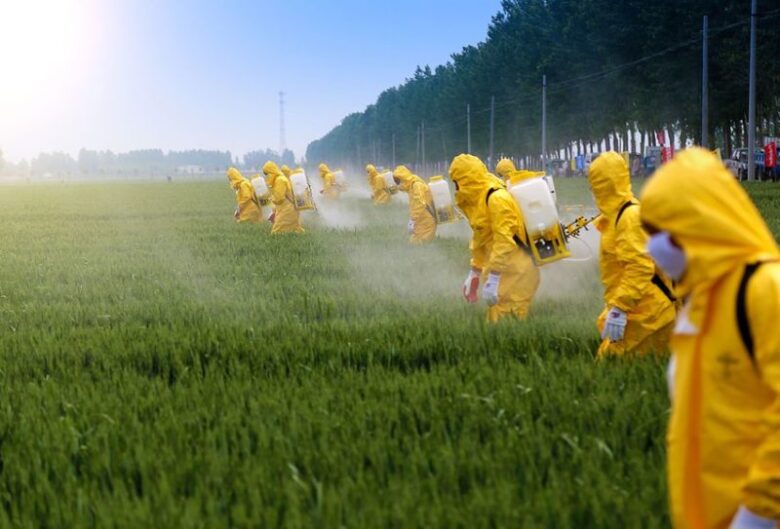RoundUp is a brand of herbicide currently owned by Bayer through its acquisition of Monsanto as of 2018. Produced by Monsanto, it is currently marketed by the Scotts Miracle-Gro company. It has been the keystone product of Monsanto’s agriculture business, representing 10% of Monsanto’s revenue well into the 2000s. Besides RoundUp, Monsanto also sold genetically modified seeds, as “Roundup Ready crops,” which were engineered to be resistant to the herbicide.
The main active ingredient of RoundUp is glyphosate, a salt-class chemical engineered and patented by Monsanto in the 1970s. It is a chemical compound which acts by inhibiting plant enzymes and is deployed to control weeds and grasses that compete with crops.

Known Effects of Glyphosate
Glyphosate is considered to have low toxicity amongst humans and other mammals. Concentrated ingestion can kill a human and some reports of skin irritation in humans have been noted, but it is unclear whether that’s from glyphosate or some other chemical in RoundUp. Laboratory tests have identified severe and carcinogenic effects in rabbits and mice when force-fed critical amounts.
Were an adult human to consume 85 ml of concentrated glyphosate, they could be subject to internal chemical burns and related distress. However, concentrated doses in suicide attempts have not always proved fatal, so certain individuals might have a higher resistance. Severe exposure can also cause skin and eye irritation, respiratory discomfort, shock, renal failure, or impaired consciousness.
Glyphosate adheres strongly to soil and can seep into groundwater through runoff. The half-life of glyphosate in soil ranges from 2 to 197 days, with a typical half-life of 47 days. In water, it has a half-life of 12 to 70 days. Glyphosate does eventually break down, primarily by microbe activity. Generally, any application of RoundUp should be expected to fade from the environment after a year. In one case, glyphosate was found to be present in a Swedish forest two years after application, but this anomaly was attributed to the soil being frozen most of the year.
It should be noted that commercial formulas applying glyphosate typically contain additives such as surfactants, which are added as a “wetting agent,” to give the herbicide penetrating and clinging effects when applied to plants. The added chemicals, individually or in combination with glyphosate, may have their own separate toxic effects or may enhance the toxicity of glyphosate itself.
Other Chemicals in RoundUp

The aforementioned surfactant in RoundUp spray is polyethoxylated tallow amine (POEA). POEA is not considered toxic and in humans, has oral toxicity no more damaging than vitamin A and less toxic than aspirin.
POEA in RoundUp does cause it to become more toxic to aquatic species, including fish and amphibians, than pure glyphosate alone.
Conclusions on Carcinogenicity
A number of regulatory health and safety organizations have ruled that “labeled uses of glyphosate have demonstrated no evidence of human carcinogenicity.” These include:
- World Health Organization (WHO)
- Food and Agriculture Organization of the United Nations (FAO)
- European Commission (EC)
- Canadian Pest Management Regulatory Agency (PMRA)
- German Federal Institute for Risk Assessment
- Australian Pesticides and Veterinary Medicines Authority
The International Agency for Research on Cancer (IARC), a scientific organization functioning within the WHO, has deemed glyphosate to be on the same level as bacon when it comes to being “probably carcinogenic to humans.” However, they have their own ranking and data sets. In France, RoundUp 360 has been banned as of January 2019, based on the IARC finding.
There has been some evidence, claimed by the IARC, that human cancer risk may increase due to occupational exposure to large amounts of glyphosate, such as that which would be incurred in a lifetime of agricultural work. However, this evidence was either too weak to come to a conclusion, or only strong enough to suggest a ‘possible’ effect. It should be noted that pesticide and herbicide effects on humans are hard to study, as so few people are exposed to them on a regular basis.
Legal Action Against RoundUp

If you feel your health may have been impacted by RoundUp usage, you can contact a lawyer, here.
Indeed, Bayer has revealed that over 13K lawsuits have been launched related to RoundUp in the US as of 2019.
In June of 2018, a California school groundskeeper who had developed non-Hodgkin lymphoma sued Bayer in San Francisco County superior court. The suit alleged both that RoundUp had caused his lymphoma, and that Monsanto had worked to suppress evidence of RoundUp’s health risks. The case currently stands favorable for the plaintiff with a settlement of $78 million, appealed by Bayer.
In March of 2019, a resident who had used RoundUp for two decades on his 56-acre property and had also contracted non-Hodgkin’s lymphoma sued in a federal court jury in San Francisco, alleging RoundUp had contributed to his condition. Judgment was for the plaintiff with an eventual settlement of $26 million. District Judge Vince Chhabria stated that “the evidence easily supported a conclusion that Monsanto was more concerned with tamping down safety inquiries and manipulating public opinion than it was with ensuring its product is safe.”
In May of 2019, a husband and wife couple in California sued Bayer, alleging they got cancer as a result of using its RoundUp weedkiller for about three decades. The settlement was for the plaintiff for $2 billion in damages. Once again, the allegation surfaced that the company has been covering up the health risks of the herbicide for decades.


